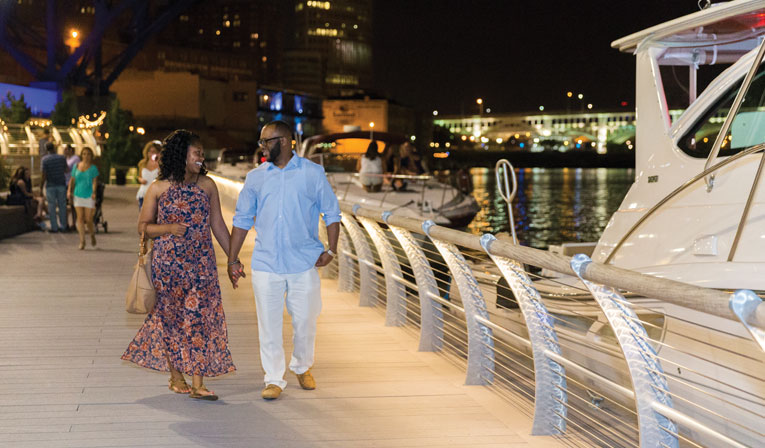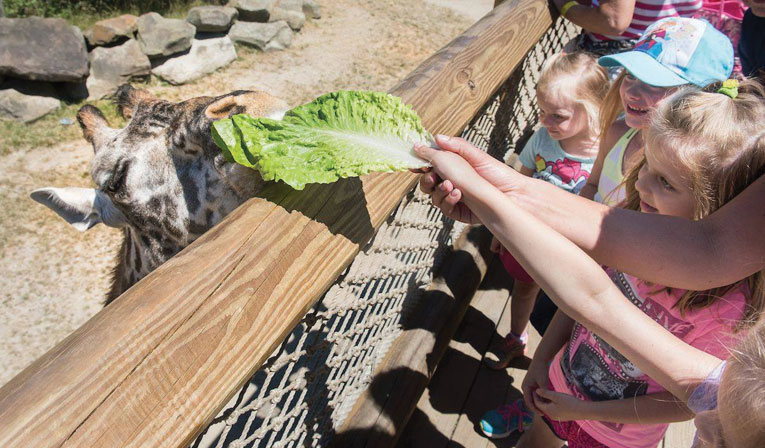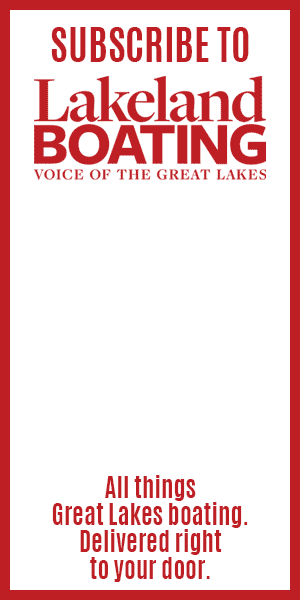Photo Courtesy of This is Cleveland
With great food, diverse neighborhoods, cultural attractions, memorable sunsets and two waterfronts — open and endless Lake Erie or the urban and industrialized Cuyahoga River — for boaters to explore, Cleveland is a cool destination.
Jim Lee is an Akron, Ohio-based IT consultant who has sailed his Ericson 30 Plus into every port on Lake Erie, but the one view that never fails to thrill him is Cleveland’s skyline.
“About 30 miles out on the lake, you start to see buildings poking up on the horizon,” Lee says, “and it’s magical how Cleveland reveals itself as you get closer.”
Marinas like the Rock and Dock make it easy to understand why Cleveland captivates Lee. The 53-slip marina occupies the heart of the city’s North Coast Harbor district, whose stellar array of attractions have reshaped Cleveland’s lakeshore and helped shred its Rust Belt reputation. Tying up there puts boaters just steps away from the famous Rock & Roll Hall of Fame, an I.M. Pei-designed masterpiece that looks like a luminous glass tent and dazzles the eye like no other building on Lake Erie. Inside, seven floors of high-energy exhibits and unrivaled memorabilia — including an original Elvis Presley recording, an Eddie Van Halen guitar, and John Lennon’s Sgt. Pepper coat — pay homage to the born-in the-USA music that rocks the world.
Also near the Rock and Dock are the family-friendly Great Lakes Science Center; the William G. Mather, a restored 1925 lake freighter that you can tour from stem to stern; the U.S.S. Cod, a World War II submarine and National Historic Landmark whose diesel engines were built in Cleveland; First Energy Stadium where Cleveland’s fiercely loyal football fans cheer their beloved Browns; and East Ninth Street Pier, a paved recreational promenade that links downtown Cleveland to the lake.
Since the pier is a popular gathering spot for everyone from fishermen to joggers, it’s a perfect place to rub shoulders with locals; it even has a lakeside restaurant, Nuevo Cleveland, that specializes in upscale Mexican cuisine and awesome views. At the very tip of the pier, Voinovich Park boasts one of the jaunty-looking Cleveland script signs that the Destination Cleveland visitors bureau has placed at scenic spots throughout the city. With the Rock Hall and city skyline as a backdrop, that pristine white sign provides the ultimate Cleveland photo-op.
Captain of industry
Cleveland began with a boat. That simple fact underscores the inescapable relationship with water that has set the city’s course since 1796, when Connecticut’s Moses Cleaveland led a surveying party into what is now Ohio’s northeast corner. Connecticut once claimed millions of acres there, and Cleaveland was tasked with mapping those vast “Western Reserve” lands so that parcels could be sold to future settlers.
Heading west along Lake Erie’s shore in a small boat (possibly an open bateau), he reached the mouth of the Cuyahoga River in July and had a site near the river’s east bank surveyed into lots surrounding a New England-style public square. His companions named the prospective settlement after him, but because of a spelling error on the plat plan, it became known as “Cleveland” instead of Cleaveland.
After the Ohio and Erie Canal connected Cleveland to the Ohio River in the 1830s and railroads arrived in the 1850s, Cleveland quickly grew into a major Great Lakes commerce center through which the riches of the heartland — grain, lumber, limestone, iron ore, coal — flowed. John D. Rockefeller, America’s first billionaire, started Standard Oil in Cleveland; Henry Sherwin and Edward Williams formed an eponymous company to make paints that are still covering the earth; and industrialists, such as Marcus Hanna, whose aid ushered William McKinley into the White House, drove manufacturing of iron, steel and ships.
While freight docks and warehouses proliferated along Cleveland’s lakefront, the Cuyahoga’s bottomland — which Clevelanders call “the Flats” — filled with foundries, refineries, factories and steel mills. Wealth and prosperity produced world-class cultural institutions, such as the Cleveland Museum of Art and Cleveland Orchestra, but it also generated successive waves of blue-collar immigrants — Irish, Germans, Italians, Poles, Slovaks, Ukrainians, Hungarians, African-Americans from the South — who turned the city into a rich tapestry of ethnic neighborhoods.
In 1908, stonemason Harry Hope arrived from England with his family. One of his sons grew up to become one of Cleveland’s favorite sons, the legendary comedian and entertainer Bob Hope. The elder Hope had worked on the monumental “Guardians of Traffic” sculptures commissioned for a 1932 Cuyahoga River bridge; those Art Deco statues are now considered iconic Cleveland symbols, and the bridge itself is called the Hope Memorial Bridge.

Photo Courtesy of This is Cleveland/Cody York
Must-See Summer Events
 • June 21 – 22: Great Lakes Burning River Fest. Support clean water with music, food and local beers on Whiskey Island.
• June 21 – 22: Great Lakes Burning River Fest. Support clean water with music, food and local beers on Whiskey Island.
• July 5 – 9, 2019: MLB All-Star Game. Hosted by the Cleveland Indians at the newly renovated Progressive Field.
• July 11 – 14, 2019: Tall Ships Festival. Onboard tours and entertainment in Cleveland harbor.
Photo Courtesy of Cleveland.com
Photo by Erik Drost
A wind of change
Fifty years ago this summer, on a June morning in 1969, an oil slick on the Cuyahoga River caught fire. The infamous blaze seriously blackened Cleveland’s reputation but it also ignited an environmental movement that resulted in federal legislation, the 1972 Clean Water Act, as well as local momentum to clean-up the heavily polluted river, redevelop the lakeshore and diversify Cleveland’s sputtering industrial economy. Something extraordinary happened during the city’s largely up-by-the boots comeback: Clevelanders discovered that the waterfronts where they had always worked could also be splendid places to play.
Today Cleveland offers boaters some of the most multi- faceted experiences available on the Great Lakes. “Once people get into Cleveland, I usually hear them say, ‘Wow!,’ when they realize how much there is see and do,” says Ed “Captain Ed” Mahoney. A Cleveland native who has logged some 30,000 miles sailing the Great Lakes, Mahoney docks his Endeavour 42 at the Cleveland Yachting Club in suburban Rocky River. As a Port Captain for the Great Lakes Cruising Club, Mahoney prepares a Cleveland harbor report that informs fellow members about everything from marina services to visitor attractions. “I always encourage people to spend enough time to really see Cleveland,” he says, “and that typically means staying three or four days.”
Among the places Mahoney recommends to boaters is Edgewater Park, a Cleveland Metroparks facility with 9,000 feet of shoreline and a beautiful swimming beach. Since Edgewater Park’s marina has limited transient dockage, plan to arrive early enough to enjoy its phenomenal views of downtown Cleveland and the Edgewater Beach House, where a seasonal café features made-to-order sandwiches. On Thursday nights, the free Edgewater LIVE concert series draws huge crowds, and many boaters simply anchor offshore to listen to the music and relish the red-orange aura of a spellbinding Lake Erie sunset.
One of the nation’s largest urban park systems, Cleveland Metroparks surrounds the city with an “emerald necklace” that includes public parks, nature preserves, golf courses, hiking and biking trails, and Cleveland Metroparks Zoo, where the Asian Highlands exhibit lets folks get face-to-face with a rare Amur tiger. In recent years, Cleveland Metroparks also began managing and improving eight lakefront parks.
“The mission of Cleveland Metroparks is connecting people with nature and that includes the water,” explains CEO Brian Zimmerman. “We’re working very hard to create places for boaters to go.”
A case in point is the upgraded East 55th Street Marina, whose facilities include a fishing platform, bait shop, ship’s store and e55 on the Lake, a restaurant serving wood-fired pizza and house-smoked brisket sandwiches. “Even e55’s potato chips are made on-the-spot, and they’re delicious,” Zimmerman says.
Zimmerman keeps his 27-foot Rinker powerboat at Edgewater Yacht Club, which, like many of Cleveland’s private marinas, makes guest docks available to Inter-Lake Yachting Association members. Edgewater is at the west end of a five-mile long breakwater that was designed to keep freighters carrying millions of tons of cargo well-protected from Lake Erie’s mercurial weather and notorious storms. But it’s also an enormous benefit for boaters because even on days when the lake roils dangerously, you can go out on much smoother water behind the breakwater.
Also within the breakwater’s protection is Whiskey Island Marina, offering transient dockage, all-new floating docks, an on-site restaurant, Still & Eatery, and more. For boaters who need some assistance, Riverfront Yacht Sales & Services is a full-service boatyard that can handle everything from boat sales and storage to service, repair and retrofit.

Photo Courtesy of Cleveland Zoo Facebook
Rolling down the river
When Zimmerman boats with his teenage son, Carter, they often head to the Cuyahoga River. “Carter really loves going up and down that river because he gets to see ships, bridges, trains, highways and ore boats unloading,” Zimmerman says.
The name Cuyahoga comes from a Native American word meaning “crooked,” and its sinuous course south of Lake Erie remains a hard-working waterway where 700-foot freighters delivering raw materials to mills and factories pass within yards of the restaurants, clubs and gentrified condos that have mushroomed on the east and west banks of the Flats.
Indeed, the Cuyahoga’s dual personality — part industrial, part entertainment — presents a unique and challenging boating experience that begins with NS1, the Norfolk Southern lift bridge spanning the mouth of the river. It’s nicknamed the “Iron Curtain” because since trains get priority, all the freighters, boaters, kayakers and paddleboarders that crowd the river must wait for it to open. The bustling river is a big part of the appeal of eateries and bars like Merwin’s Wharf (its giant pretzel with beer cheese sauce is a local fave) and Alley Cat Oyster Bar (home of the Cat’s Pajamas vodka and lemonade elixir), but for many folks, the eLClee2 water taxi is the most convenient way to shuttle to the fun-and-games venues on both sides of the Flats.
To reach Cleveland attractions that aren’t on the water, boaters use taxi cabs, Uber, rental cars, and the Regional Transit Authority. At the RTA’s East Ninth/North Coast Harbor station, you can ride the Waterfront Line to Tower City Center’s central station and make connections to destinations throughout the city. A mixed-use shopping and office complex, the Center includes Terminal Tower, a landmark 1920s skyscraper on Public Square, which, just as Moses Cleaveland intended, is still the hub of downtown Cleveland. A Public Square statue depicts Cleaveland holding a surveyor’s staff and compass. On weekends, Terminal Tower’s observation deck affords panoramic views of his namesake city.
Celebrating Cleveland
You can see some of Cleaveland’s actual surveying tools at the Western Reserve Historical Society’s Cleveland History Center in University Circle. Its “Cleveland Starts Here” exhibit features 220-plus years of artifacts that include the first DeLorean automobile and the shoes LeBron James wore when he led the Cleveland Cavaliers to their first NBA championship in 2016. Besides being exceptionally pretty, University Circle is Cleveland’s cultural, intellectual and medical crossroads. Its mainstays include the renowned Cleveland Clinic, Case Western Reserve University and the incomparable Cleveland Museum of Art, where you can revel in the genius of Renoir, Rodin and Picasso for free and have lunch in a sunny atrium.
While you’re in the neighborhood, take time to visit Lake View Cemetery, the arboretum-like resting place of Cleveland movers and shakers ranging from John D. Rockefeller to Alan Freed, the disc jockey who popularized the term “rock and roll” and is interred beneath a headstone resembling a jukebox. In nearby Rockefeller Park, you can tour the Cleveland Cultural Gardens, a unique collection of nationality gardens that celebrate the city’s ethnic diversity — think Doric columns in the Greek Garden and birch trees in the Latvian Garden.
Given its melting pot tradition, Cleveland is a great food city. In Little Italy, the cassata at Corbo’s Bakery is sweet nirvana. In Tremont, Sokolowski’s University Inn serves pierogi and cabbage rolls cafeteria-style. And in Ohio City, the West Side Market is a veritable cornucopia of kielbasa, kolacky and other ethnic specialties.
The two celebrity chefs who put Cleveland on the national culinary map both have flagship restaurants — Michael Symon’s Lola and Jonathon Sawyer’s Greenhouse Tavern — on East 4th Street, a pedestrians-only boulevard lined with pubs, clubs and eateries. East 4th is probably the hippest block in Cleveland. Along with the gigantic outdoor chandelier marking the beautifully restored theaters of the Playhouse Square (the nation’s largest performing arts district outside New York City) and the leg lamp glowing in the front window of A Christmas Story House and Museum (where the much-loved Christmas movie was filmed), East 4th Street epitomizes Cleveland’s renewed hometown pride and almost palpable energy.
“Cleveland has done a fine job of owning who we are as a city,” Zimmerman says. “People who live here are passionate about the city. They celebrate Cleveland and enjoy it.”





